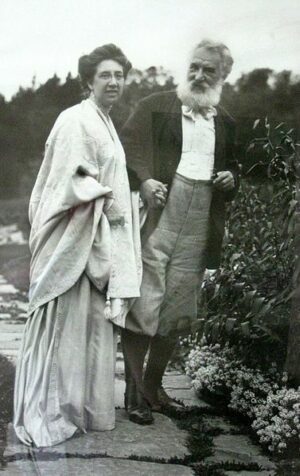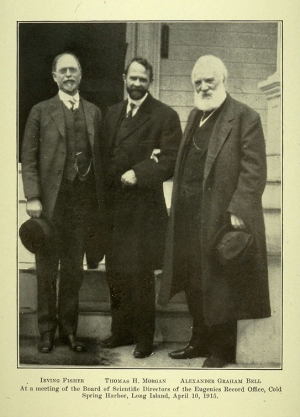
The Invention of Miracles, by Katie Booth (Simon & Schuster 2021)
Review of The Invention of Miracles: Language, Power, and Alexander Graham Bell’s Quest to End Deafness, by Katie Booth (Simon & Schuster 2021)
Alexander Graham Bell has long been a polarizing figure, admired as the brilliant inventor of the telephone and other extraordinary devices, but also despised as the leading exponent of oralism, the movement that pressured deaf people to learn speech and, more important, not to learn sign language. He had a deaf mother and a deaf wife, but he worked relentlessly to normalize their deafness, hoping that they might become such clever facsimiles of hearing people as to be spared the disadvantages of their manifest disability.
In his later life, Bell was loosely associated with eugenics, perhaps the most misguided of all Victorian ideologies. He never advocated for deaf people to be sterilized; in fact, he opposed such practices. But he did try to persuade deaf people not to marry one another, because he feared that they would pass on their disability and create a “defective variety of the race.” He recruited prominent figures to his side, including Helen Keller, who dedicated her first memoir to him, and who initially understood herself the way he understood her: as an inspirational but broken human being. “I can’t imagine a man wanting to marry me,” she said. “I should think it would seem like marrying a statue.”
Katie Booth’s biography of Bell, The Invention of Miracles, has been in the works for 15 years; her meticulous research and rigor are evident on every page. Engagingly written, the book enlivens a life that has often appeared dry in other accounts. Booth’s descriptions of Bell’s passionate courtship of his student Mabel Hubbard, who belonged to a much higher social class, are as stirring as a romance novel, and her narrative of his work on the telephone reads like a thriller. One comes away feeling deeply connected not only to Bell, but also to Mabel and a host of subsidiary characters.

Alexander Graham Bell with Helen Keller and Annie Sullivan at the meeting of the American Association to Promote the Teaching of Speech to the Deaf, July 1894, in Chautauqua, N.Y. Source: Library of Congress.
Born in Scotland in 1847, Bell was the son and grandson of elocutionists, and his driving passion was to understand how human beings create the sounds that make up speech. He produced a speaking machine that replicated a range of phonemes when properly aerated, and continued to tinker with ways of bringing forth spoken words where no such words had been heard before; he even tried to teach speech to his dog. His father had designed a universal alphabet to represent the mechanics of articulation, and Alexander Graham Bell lectured widely on its importance, certain that anyone would be able to verbalize any language transliterated into these symbols.
That anyone included deaf people. Bell believed that with the correct methods, they could learn to speak, and be integrated into the larger society. As he tried to understand hearing and sound, he stumbled into inventions. Though the telephone made him rich, he had relatively little emotional attachment to it, seeing it as a distraction from his wish to reform the education of deaf people. (Nevertheless, he devoted years to defending his patents, which some critics believe were granted unfairly; if Bell did invent the telephone, he stood on the shoulders of giants.)
Mabel had lost her hearing as a child, a consequence of scarlet fever, after learning some speech, and she was able to master verbal communication anew. Bell believed that others would share her aptitude if properly taught. But he did nothing to lift the stigma that even she associated with her condition; Mabel long refused to socialize with other deaf people because to do so “instantly brought the hardly concealed fact [of my own deafness] into evidence.”

Mabel Gardiner Hubbard Bell and Alexander Graham Bell at their home in Brantford, Ontario, c. 1915. Source: Wikimedia Commons.
Bell seems to have been disconnected from most human drama; the man Booth describes sounds as though he may have been on the mild end of the autism spectrum, as many great inventors are. She believes he was lonely in his later life, rather a sad man, but the evidence she presents suggests he was merely a loner in his intellectual adventures and, Mabel notwithstanding, not much drawn to intimacy. His mind was fixed on the human voice, and everything else came second, including his own family. That detachment perhaps explains the failures of empathy that poisoned his relationship with the very people he wished to serve. Mabel said: “Your deaf mute business is hardly human to you. You are very tender and gentle to the deaf children, but their interest to you lies in their being deaf, not in their humanity.”
Immune to the beauty of sign language, Bell never saw deafness as anything more than a deficit, though already in his day deaf people were organizing around the defense of their language and society. The oralism Bell championed was a disaster for the deaf. While examples abound of deaf people who have mastered speech, they do not represent the larger deaf community; an acuity at producing sounds is a splinter talent. Moreover, instructing deaf people on the mechanics of speech is terribly time-consuming, and those who aspire to this skill can do so only by ignoring all other domains of education. Deaf people in a signing environment are likely to learn mathematics and science and literature, while those raised orally learn pronunciation and little else. Finally, oralism implicitly teaches a kind of self-abnegation — that deaf people are of value only insofar as they can approximate another kind of person. Devoted oralists believed that sign language should be forbidden in oralist environments, which meant that language acquisition in oralist schools was painfully gradual. Without early language development, as Booth notes, the human mind cannot fully develop, and many children taught orally acquire little or no language during the crucial window of brain plasticity.
There is no question that deaf people who master speech have access that other deaf people don’t have. But Booth is at pains to point out that such people are not necessarily happier than those who live in the segregated world of the signing deaf. Not only did Bell’s educational strategy threaten to obliterate an exquisite deaf culture with its own language and traditions, but also, it didn’t work: only about 10 percent of deaf people who received an oral education ended up functioning comfortably in the hearing world.
Booth is doubly outraged: at what Bell wanted to do and at the psychic cost of the method by which he proposed to do it. Her book is a partisan rallying cry fueled in part by her experience of having two deaf grandparents. “When my grade-school social studies book said that Alexander Graham Bell was the inventor of the telephone, it sounded as absurd to me as introducing Adolf Hitler as a vegetarian who once ruled over Germany,” she writes. It’s an arresting comparison, but it doesn’t take into account that Bell’s humanism, though often misguided, was of an entirely different nature than Hitler’s monstrosity. Everything Booth says in this eloquent biography is backed up persuasively, but her yearning to correct the record should be balanced against the uncorrected record that has obtained previously. Though she attempts to wave the flag of impartiality, she is deeply invested in indicting her subject.

Irving Fisher, T.H. Morgan, and Alexander Graham Bell at Eugenics Record Office Board Meeting, April 10, 1915, Eugenical News (vol. 14:8). Source: Eugenics Archive.
Bell, Booth complains, was incapable of recognizing “a larger struggle between normalcy and difference, between saving and being saved, between empowerment and charity” — a struggle that very few people recognized in his day. He “would start playing God,” she writes of his efforts to stop intermarriage among the deaf, “trying to control birth, trying to bring about an end to deafness.” She often sounds irritable, even smug, about Bell’s shortcomings. “Bell never saw the deaf community as a valuable one,” she declares. “He believed, against all evidence, that social cures for deafness had to be found by integrating the deaf with the hearing; he believed that deafness was inherently lonely. But it was Bell to whom loneliness clung, even if his greatest effort was to lift it.”
Bell was emblematic of a larger Victorian movement to normalize that we reject today only incompletely. In the current moment of racial reckoning, with assimilation out of fashion, Bell’s proposals look ugly, but one must consider that even now, many people who have differences and disabilities would prefer to fit in. That doesn’t invalidate their lived experience, which may be rich in ways that others fail to recognize or even imagine; it merely reflects the social pressure toward homogeneity that has become ever stronger since the Industrial Revolution. We can keep fighting that pressure, as the disability rights movement does, but new normalizing procedures are being invented all the time.
Booth’s prologue and afterword concern her deaf grandparents and her own experience in the signing world, and she maintains that the trauma her family endured was Bell’s legacy. I am with Booth in hoping that visionaries such as Bell do not succeed in narrowing the range of what it is to be human, that they don’t destroy whole cultures. Language extinction is an urgent problem of our era; by the end of the century, half the languages currently spoken will have vanished from use, and only the heroic effort of a relatively small group of committed linguists will preserve any record of them. American Sign Language is more robust than many endangered languages; it is taught in major universities even to hearing people who may have no immediate need for it.
Bell’s wish that everyone understand everyone else came at a terrible price, but it was the product of its time. Booth’s anger reflects a current trend of holding people from the past to standards of the present. In her afterword she is critical of the cochlear implant, which has effectively achieved what Bell set out to do. Children with implants should, as Booth argues, have access to sign in case they don’t process sound fluently. But most children who receive them are “normalized” into their parents’ mainstream culture, thus diminishing the population of functionally deaf people. That’s all that was needed; deaf culture went on the chopping block the minute an obliterative procedure was developed. Now that Bell’s dream has come true — albeit with a different intervention than the one he championed — we have to consider Booth’s impassioned biography as part of a larger battle, valiant but probably unwinnable, against cultural erasure and standardization.











